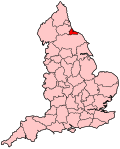Langbaurgh (UK Parliament constituency)
| Langbaurgh | |
|---|---|
| Former County constituency for the House of Commons | |
 Boundary of Langbaurgh in Cleveland for the 1992 general election | |
 Location of Cleveland within England | |
| County | 1983-1996 Cleveland 1996-1997 North Yorkshire |
| Major settlements | Guisborough |
| 1983–1997 | |
| Seats | One |
| Created from | Cleveland & Whitby |
| Replaced by | Middlesbrough South & East Cleveland |
Langbaurgh was a
.History
The constituency was a mixture of heavy manufacturing areas (41.7% of the workforce), with seaside resort and rural agricultural parts. The political effect was to make the constituency marginal between the Labour and Conservative candidates. However, it was held by the Conservative party at each of the general elections which it existed. A 1991 by-election was the only time at which Labour won this seat.
Boundaries
1983–1997: The Borough of Langbaurgh wards of Belmont, Brotton, Guisborough, Hutton, Lockwood, Loftus, Longbeck, St. Germain's, Saltburn, Skelton, and Skinningrove, and the Borough of Middlesbrough wards of Easterside, Hemlington, Marton, Newham, Nunthorpe, Park End, and Stainton and Thornton.[1]
At the time of its creation the constituency was part of the then
The redistribution of constituencies, which took effect in 1983, was the first which used the reformed local authorities as the building blocks for Parliamentary constituencies. Langbaurgh was a new constituency; 65.1% of it had formerly been part of Cleveland and Whitby constituency, 34.6% came from Middlesbrough and 0.3% from Richmond (Yorks).
In 1996 the county of Cleveland and its associated districts like the borough of Langbaurgh were abolished. The area was divided into
Members of Parliament
| Election | Member[2] | Party | Notes | |
|---|---|---|---|---|
| 1983 | Richard Holt | Conservative | Died September 1991 | |
| 1991 by-election | Ashok Kumar |
Labour | Later MP for Middlesbrough South and East Cleveland 1997–2010 | |
| 1992 | Michael Bates | Conservative | Paymaster General 1996–97 | |
| 1997 | constituency abolished: see Middlesbrough South and East Cleveland & Redcar | |||
Elections
Elections in the 1990s
The 1992 result is compared to the 1987 general election vote, which was a Conservative win.
| Party | Candidate | Votes | % | ±% | |
|---|---|---|---|---|---|
| Conservative | Michael Bates | 30,018 | 45.4 | +3.7 | |
| Labour | Ashok Kumar | 28,454 | 43.1 | +4.7 | |
| Liberal Democrats | Peter Allen | 7,615 | 11.5 | −8.4 | |
| Majority | 1,564 | 2.4 | −1.0 | ||
| Turnout | 66,087 | 83.1 | +4.3 | ||
| Conservative hold | Swing | −0.5 | |||
| Party | Candidate | Votes | % | ±% | |
|---|---|---|---|---|---|
| Labour | Ashok Kumar | 22,442 | 42.9 | +4.5 | |
| Conservative | Michael Bates | 20,467 | 39.1 | −2.6 | |
| Liberal Democrats | Peter Allen | 8,421 | 16.1 | −3.8 | |
| Green | Gerald Parr | 456 | 0.9 | New | |
| Yorkshire Party | Colin Holt
|
216 | 0.4 | New | |
| Corrective Party | Lindi St Clair | 198 | 0.4 | New | |
| Football Supporters | Nigel Downing | 163 | 0.3 | New | |
| Majority | 1,975 | 3.8 | N/A | ||
| Turnout | 52,363 | ||||
| Labour gain from Conservative | Swing | +3.55 | |||
Elections in the 1980s
| Party | Candidate | Votes | % | ±% | |
|---|---|---|---|---|---|
| Conservative | Richard Holt | 26,047 | 41.7 | 0.0 | |
| Labour | Paul Harford | 23,959 | 38.4 | +7.0 | |
| Liberal | Robin Ashby | 12,405 | 19.9 | −7.0 | |
| Majority | 2,088 | 3.4 | -7.0 | ||
| Turnout | 62,411 | 78.8 | +3.8 | ||
| Conservative hold | Swing | −3.5 | |||
| Party | Candidate | Votes | % | ±% | |
|---|---|---|---|---|---|
| Conservative | Richard Holt | 24,239 | 41.7 | ||
| Labour | Gaye Johnson | 18,215 | 31.4 | ||
| Liberal | Robin Ashby | 15,615 | 26.9 | ||
| Majority | 6,024 | 10.4 | |||
| Turnout | 58,069 | 75.0 | |||
| Conservative win (new seat) | |||||
See also
- List of former United Kingdom Parliament constituencies
- History of parliamentary constituencies and boundaries in Cleveland
Notes and references
- ^ "The Parliamentary Constituencies (England) Order 1983". www.legislation.gov.uk. Retrieved 3 February 2019.
- ^ Leigh Rayment's Historical List of MPs – Constituencies beginning with "L" (part 1)
- ^ "Election Data 1992". Electoral Calculus. Archived from the original on 15 October 2011. Retrieved 28 June 2017.
- ^ "Politics Resources". Election 1992. Politics Resources. 9 April 1992. Archived from the original on 24 July 2011. Retrieved 6 December 2010.
- ^ "Election Data 1987". Electoral Calculus. Archived from the original on 15 October 2011. Retrieved 28 June 2017.
- ^ "Election Data 1983". Electoral Calculus. Archived from the original on 15 October 2011. Retrieved 28 June 2017.
Sources
- British Parliamentary Constituencies: A Statistical Compendium, by Ivor Crewe and Anthony Fox (Faber & Faber 1984)
